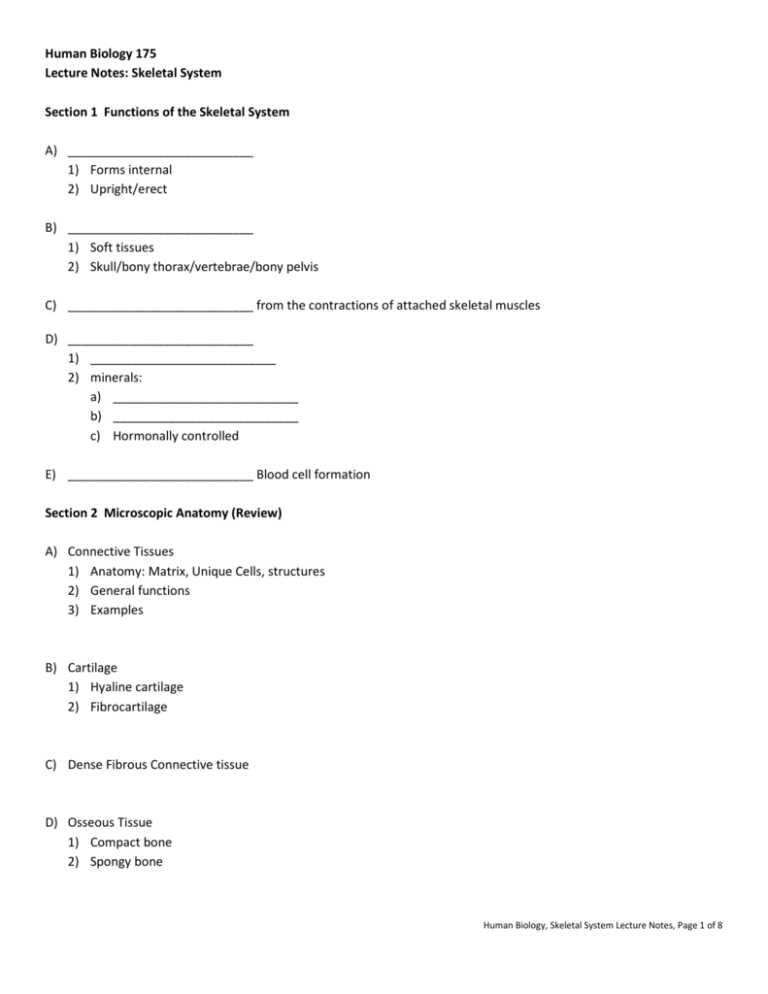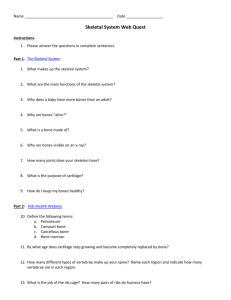Human Biology 175 Lecture Notes: Skeletal System Section 1
advertisement

Human Biology 175 Lecture Notes: Skeletal System Section 1 Functions of the Skeletal System A) ___________________________ 1) Forms internal 2) Upright/erect B) ___________________________ 1) Soft tissues 2) Skull/bony thorax/vertebrae/bony pelvis C) ___________________________ from the contractions of attached skeletal muscles D) ___________________________ 1) ___________________________ 2) minerals: a) ___________________________ b) ___________________________ c) Hormonally controlled E) ___________________________ Blood cell formation Section 2 Microscopic Anatomy (Review) A) Connective Tissues 1) Anatomy: Matrix, Unique Cells, structures 2) General functions 3) Examples B) Cartilage 1) Hyaline cartilage 2) Fibrocartilage C) Dense Fibrous Connective tissue D) Osseous Tissue 1) Compact bone 2) Spongy bone Human Biology, Skeletal System Lecture Notes, Page 1 of 8 Section 3 Classification of Bones A) ≈206 Bones in Adult Human Skeleton 1) ______________________________ Skeleton (along main axis of the body) 2) ______________________________ skeleton (Limbs and their attachments) B) Bones are classified according to their shape: 1) _______________ a) Thin/curved b) Example: (1) ______________________________ (parietal/frontal) (2) ______________________________ (3) ______________________________ 2) _______________ a) ‘cube’ shaped b) Mostly spongy bone c) Examples: (1) ______________________________ wrist bones (2) ______________________________ ankle bones (3) ______________________________ (sesamoid bone) 3) _______________ a) Unique shapes b) Examples: (1) ______________________________ spine (2) ______________________________ hip 4) _______________ a) Mostly compact bone b) Most bones of the limbs: (1) ______________________________ brachium (2) ______________________________ thigh (3) ______________________________ fingers/toes (4) Structure of a typical Long bone c) ____________________ ends (1) compact bone surrounds spongy bone interior (2) ________________________________ (hyaline) covers surface (3) ________________________________ occupies spongy bone interior d) ____________________ shaft/length (1) Compact bone (2) ___________________________ fibrous connective tissue (3) ___________________________ space (4) ___________________________ membrane lines lumen (5) ___________________________ adipose fills medullary cavity Human Biology, Skeletal System Lecture Notes, Page 2 of 8 Section 4 Axial Skeleton A) Axial Skeleton includes: 1) _______________ 2) _______________ 3) _______________ 4) _______________ B) Skull: 1) ________________________ protects brain and site of muscle attachment a) 8 Bones: (1) Frontal (2) Parietal (3) Occipital (4) Temporal (5) Sphenoid (6) Ethmoid b) ________________________ spaces (1) Decrease weight (2) Resonance in voice 2) ________________________ site of muscle attachment/orbits/ expressions a) 14 Bones: (1) Maxilla (2) Palatine (3) Zygomatic (4) Lacrimal (5) Nasal (6) Vomer (7) Inferior nasal conchae (8) Mandible: only movable bone of the skull b) Hyoid bone: does not articulate any other bone in the body (muscle attachment—tongue/larynx) Human Biology, Skeletal System Lecture Notes, Page 3 of 8 C) Vertebrae 1) General Functions: a) ________________________ head and trunk b) ________________________ spinal cord and spinal nerves c) Site for muscle attachment d) ________________________ (1) prevent/absorb shock (2) Flexible (3) Center body weight over lower limbs 2) ________________________ vertebrae (C1-C7) a) Smallest/light weight b) C-1 Atlas _______________ c) C-2 Axis _______________ 3) ________________________ vertebrae (T1-T12) a) Articulate with costals (ribs) b) ________________________ heart/lungs c) ________________________ change thoracic cavity volume (move blood/lymph/air) 4) ________________________ vertebrae (L1-L5) a) Large/block-like b) Receives most of body weight 5) ________________________ vertebrae (S1-S5) a) ________________________ b) Contributes to bony pelvis c) _______________ for spinal nerves 6) ________________________(3-5) a) ________________________ b) ‘tailbone’ D) Bony thorax 1) Components: (1) ________________________ (2) ________________________ (3) ________________________ hyaline cartilage (4) ________________________ 2) Function: (1) ________________________ heart and lungs (2) ________________________ changes in volume move blood/lymph/air b) ‘tailbone’ 3) Costals a) Male vs. female b) ______________ 7 pairs ribs attached directly to sternum c) ______________ 5 pairs indirectly/not attached to sternum (1) ____________________ d) Intercostal muscles aid in breathing Human Biology, Skeletal System Lecture Notes, Page 4 of 8 Section 5 Appendicular Skeleton A) Pectoral Girdle and Arm 1) Pectoral Girdle a) Components: (a) _______________ (b) _______________ b) Light weight c) only attached to axial skeleton at sternoclavicular joint d) Glenoid cavity shallow/poorly reinforced with ligaments e) Advantage: ___________________ f) disadvantage: __________________ 2) Arm a) Brachium: ________________ (1) Head fits into glenoid cavity of scapula b) Antebrachium: (1) ______________ (lateral) (2) ______________ (medial) c) Wrist: ____________ d) Palm: ________________ e) Fingers: ________________ (1) Finger: proximal, middle distal (2) Pollux: proximal, distal B) Pelvic Girdle and leg 1) Pelvic Girdle: _______________ a) 3 Fused bones: (1) _______________ (2) _______________ (3) _______________ b) Large and heavy c) Function (1) Articulate with femur (acetabulum) (2) protect reproductive/urinary organs (3) Holds upper body weight 2) Leg a) Thigh:___________________ b) Knee: ___________________ c) Leg: (1) Lateral: __________________ (2) Medial: __________________ d) Ankle: __________________ (1) Calcaneus e) Instep/sole: __________________ f) Digits: __________________ (1) proximal/middle/distal (2) Hallux: proximal/distal Human Biology, Skeletal System Lecture Notes, Page 5 of 8 Section 6 Bone Growth and Repair A) ____________________ bone formation 1) ____________________ build bone 2) ____________________ mature bone cells 3) ____________________ break down bone 4) Controlled by a) Hormones b) Gravity and use B) Bone Development 1) Embryonic development: a) Skeleton begins as a Hyaline Cartilage model (bone replaces hyaline) 2) Fetal Skeleton: a) >206 bones (more than human adult skeleton) b) ____________________________________ Develops from Hyaline Cartilage model (bone replaces hyaline) c) ___________________ fibrous connective tissue between cranial bones (1) allows for ______________________________ during birth process and growth 3) After birth: a) ___________________________________ bone that develops between sheets of fibrous connective tissue (1) Replaces the ________________________ (2) Ossification complete 20-24 months of age (3) Examples: coronal/sagittal and lambdoid sutures b) ________________________ band of hyaline cartilage that continues to grow (1) Cartilage is replaced by bone (2) Increases the length/diameter of the bone (3) Hormonally controlled: (a) Growth hormone (pituitary gland) (b) Sex hormones c) _____________________________ bone is constantly being formed/broken down (1) __________________: entire skeleton replaced 4X over lifetime (2) Maintain normal proportions as we grow (3) Projections will increase with demand (4) Contributes to maintaining (relatively) constant blood __________________ levels (a) Osteoblasts ______________ blood Ca2+ levels (b) Osteoclasts ______________ blood Ca2+ levels (c) Important: nerve impulses, muscle contraction (5) Blood calcium levels are hormonally controlled Human Biology, Skeletal System Lecture Notes, Page 6 of 8 C) Bone Repair (fracture = break) 1) _______________________________ broken blood vessels allow blood to fill space between the broken bones causing cellular death. 2) _______________________________ forms a) Hyaline cartilage and fibrous connective tissue connect the broken bones b) New capillaries form c) Phagocytes dispose of debris/dead tissue 3) _______________________________ spongy bone replaces the fibrocartilage callus connecting the bones 4) _______________________________ a) osteoblasts build compact bone on the periphery b) Osteoclasts breakdown bone forming medullar cavity c) Dependent upon mechanical stress Human Biology, Skeletal System Lecture Notes, Page 7 of 8 Section 7 Articulations A) ________________________ (joint) where two(+) bones join together and may allow mobility B) Structural Classification 1) Based on ________________________ 2) _________________________________ immovable a) Collagen fibers hold bones together b) Function: __________________________ c) example: skull sutures 3) ______________________________________ immovable/slightly movable a) Hyaline cartilage: (1) _________________________________ contributes to breathing (slightly movable) (2) _________________________________ immovable b) Fibrocartilage: (1) _____________________________________ slightly movable (2) _____________________________________ slightly movable 4) _________________________________ Freely Movable a) Two bones separated by cavity b) Hyaline protects epiphysis from grinding c) Fibrous CT and ligaments form capsule d) Lined with synovial membrane e) Synovial fluid lubricates/cushions during movements Human Biology, Skeletal System Lecture Notes, Page 8 of 8







